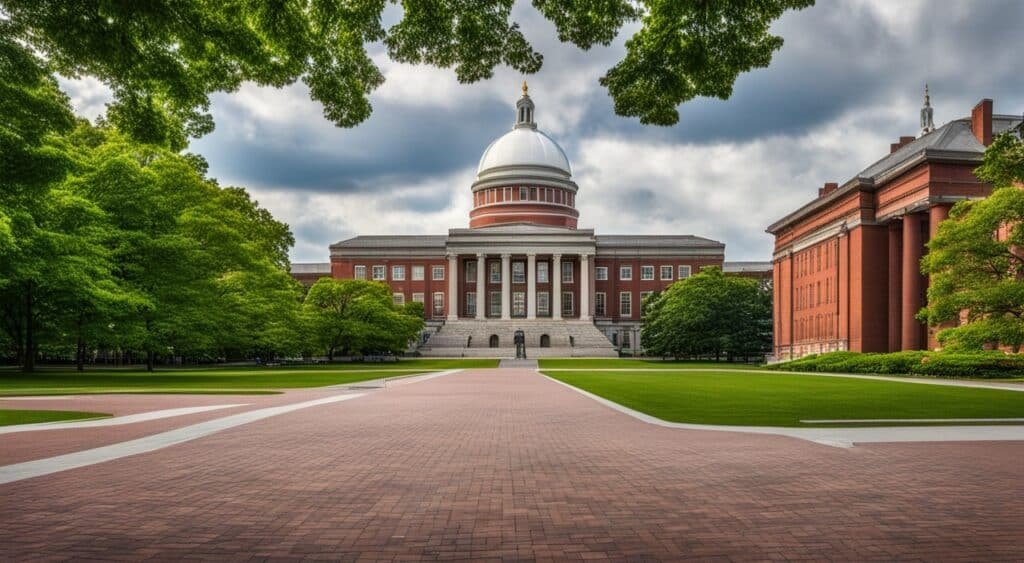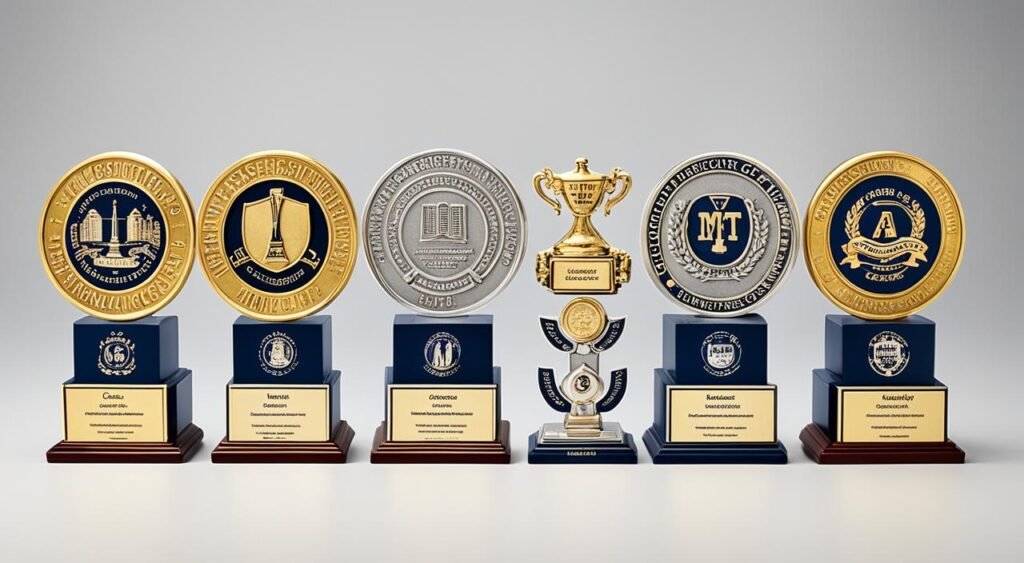The Massachusetts Institute of Technology (MIT) is a top research university in Cambridge, Massachusetts. It has led in scientific innovation for over a century. Founded in 1861, it was first called the “Massachusetts Institute of Technology and Boston Society of Natural History.” William Barton Rogers led it early on.
MIT is a hub for entrepreneurship and innovation. It has helped create more than 100 founders of famous companies. These include Dropbox, Intel, HP, Boeing, and many others.
MIT’s campus covers 166 acres and houses over 30 academic departments and research centers. It also has more than 20 public art pieces. With about 4,700 undergrads and 10,000 students total, it’s very competitive.
MIT is famous for its top research, modern facilities, and excellent faculty. These have brought it many awards, like Nobel Prizes and Turing Awards.
Key Takeaways
- The Massachusetts Institute of Technology (MIT) is a prestigious research university founded in 1861 and located in Cambridge, Massachusetts.
- MIT has a long history of supporting entrepreneurship and innovation, having produced over 100 founders and co-founders of famous companies.
- The MIT campus spans over 166 acres and is home to more than 30 academic departments and research centers, as well as over 20 public art installations.
- MIT is highly competitive, with an undergraduate enrollment of around 4,700 students and a total enrollment of approximately 10,000 students.
- MIT is known for its exceptional research, state-of-the-art facilities, and world-class faculty, earning it numerous notable awards and accolades.
The Vision and Mission of MIT’s Founding
MIT was started in 1861 by William Barton Rogers, a famous natural scientist. He wanted to create a new kind of college for the fast-changing world of science and technology. Rogers had three main ideas that shaped MIT’s early goals.
William Barton Rogers’ Pioneering Vision
William Barton Rogers was active in the Massachusetts state legislature and the Boston Society of Natural History. He saw the need for a school that valued useful knowledge. He wanted to mix professional and liberal arts education at the college level. His dream was to teach by doing, using laboratory instruction.
The Principles of the Rogers Plan
- The educational value of useful knowledge in science and technology
- The need for learning by doing through hands-on experiments
- Combining a professional and liberal arts education at the college level
Integrating Theory and Practice
MIT was built on the idea of linking theory with practice. It aimed to teach the scientific principles behind the arts, not just the arts themselves. This focus on integrating theory and practice has made MIT known for its unique approach to education and research.
Also Read: MBA Scholarship Programs In USA
Boston Tech: MIT’s Early Years (1865-1916)

The early days of the Massachusetts Institute of Technology, known as “Boston Tech,” faced big financial hurdles and changes in leadership. The first classes started in 1865 in the Mercantile Building in Boston. By 1866, the institute had its first building in Back Bay.
Overcoming Financial Challenges
The 1870s were tough for MIT due to the Panic of 1873 and the Long Depression. These issues cut faculty salaries and led to the loss of three professorships. Yet, leaders like John Daniel Runkle, Francis Amasa Walker, and Henry Pritchett worked hard to keep MIT going.
Expanding Academic Programs
Despite the tough times, MIT’s academic offerings grew. New fields like Electrical Engineering, Chemical Engineering, and Sanitary Engineering were added. This made education at Boston Tech more diverse.
Building a Sense of Community
Under Francis Amasa Walker, MIT focused on improving student life and connecting with alumni. Walker backed the gym, dorms, and the Technology Club. This helped build a strong community among students and alumni.
“The history of the Massachusetts Institute of Technology is one of perseverance and innovation in the face of adversity.”
MIT’s Transition to Cambridge

In 1916, MIT moved from Boylston Street in Boston’s Back Bay to Cambridge. This move was a big change for the Institute. The old campus was too small for MIT’s growing needs.
Also Read: Top Student Activities To Enjoy At University
President Francis Amasa Walker led the move. He wanted to build a new campus across from Trinity Church. The plan was to sell the old land to fund the new site. But, the Walker Building, built in 1883, didn’t quite fit in with the area.
MIT also started building another Copley Square building in 1892. This building was meant to help with the growing student body. The 1892 Copley Square Building was a temporary fix before the big move to Cambridge in 1916.
| Year | Milestone |
|---|---|
| 1883 | MIT constructs the Walker Building in Copley Square, Boston |
| 1892 | MIT builds the Copley Square Building in Boston |
| 1916 | MIT moves its campus from Boston to its current location in Cambridge |
The move to Cambridge was a key moment for MIT. It allowed the Institute to grow and stay connected to Boston. This move helped MIT become the leader in innovation it is today.
Also Read: What Is A Life Insurance Retirement Plan?
Massachusetts Institute Of Technology’s Research Breakthroughs

The Massachusetts Institute of Technology (MIT) leads in research and technological innovation. It’s known for its groundbreaking work in science and technology. This makes it a top name worldwide in these areas.
Pioneering Developments in Science and Technology
MIT covers many fields, like engineering, physical sciences, and more. It has greatly influenced science and tech progress. This includes the first digital computer, Apollo space program, and recent advances in artificial intelligence, robotics, and energy technologies.
Contributions During World War II
During World War II, MIT made a big impact. It ran the Radiation Laboratory, a key center for radar research and development. Other military laboratories also played a big part in helping the Allies.
“MIT’s research has spanned a wide range of fields, from developing the first digital computer and contributing to the Apollo space program to more recent advancements in areas such as artificial intelligence, robotics, and energy technologies.”
MIT’s work in science and technology has expanded human knowledge and capabilities. It has made huge contributions to society’s progress.
Also Read: Computer Science Top Universities In US
MIT’s Interdisciplinary Approach

At the Massachusetts Institute of Technology (MIT), knowledge and innovation come from working together across different fields. This mix of various skills helps solve complex problems in new ways. It leads to big discoveries and solutions that change the world.
MIT’s team, including students and teachers, work without limits. They combine engineering, science, architecture, and management to work on exciting projects. This teamwork brings together different areas of knowledge to achieve amazing things.
Collaboration Across Disciplines
MIT’s work isn’t just on campus in Cambridge, Massachusetts. It also happens at the MIT Lincoln Laboratory, a place for research on national security. Here, MIT experts work with government and industry to solve big issues like defense and cybersecurity.
Also Read: What Are The Different Types Of Business Insurance?
| Interdisciplinary Collaboration at MIT | Highlights |
|---|---|
| Departments and Research Centers | MIT’s departments, from engineering to management, team up on projects. This way, they share their knowledge and skills. |
| Off-Campus Facilities | The MIT Lincoln Laboratory is where MIT and others work together. They focus on national security and solve big problems. |
| Groundbreaking Innovations | MIT’s teamwork has led to big discoveries in science and technology. It helps solve complex issues from many angles. |
MIT’s way of working together has made it a leader in research and education worldwide. It’s all about solving big challenges with a team effort. This approach has created a place where innovation and discovery are key.
The MIT Media Lab: Exploring New Frontiers
Since 1985, the MIT Media Lab has led in tech innovation. It pushes limits and explores new tech to make art, communication, and how we interact with computers better. The Lab’s work spans computer science, engineering, design, and the arts.
Notable Projects and Initiatives
Some key projects from the Media Lab include:
- The development of Scratch, a language for kids to learn coding.
- The Personal Robots group’s work on robots that interact more naturally with humans.
- The City Science group’s efforts to make cities sustainable and livable with new tech.
| Project | Focus | Impact |
|---|---|---|
| Scratch | Programming language for children | Introduced a new way for kids to learn coding and create their own interactive stories, games, and animations. |
| Personal Robots | Developing more natural and intuitive human-robot interaction | Pioneered advancements in social robotics, enabling robots to better understand and respond to human behavior. |
| City Science | Creating sustainable and livable cities | Explored the use of technology to address urban challenges and improve the quality of life in cities. |
These projects show the MIT Media Lab’s drive to explore new areas in computer science, engineering, design, and the arts.
“The MIT Media Lab is a unique place where the future is being invented every day.”
MIT’s Entrepreneurial Spirit
The Massachusetts Institute of Technology (MIT) is known for its strong entrepreneurial spirit and constant innovation. This has led to over 100 founders and co-founders of famous companies. These include Dropbox, Intel, HP, Boeing, TSMC, Akamai, Bose, Qualcomm, Thermo Fisher, and Raytheon.
Supporting Innovation and Startups
MIT really cares about entrepreneurship and startups. It has many programs, initiatives, and resources to help. These include seed funding, mentorship, special courses, and networking chances.
“MIT has created a unique place that helps students, faculty, and alumni make their dreams come true. Its strong support for entrepreneurship and innovation has helped many startups and leaders in the industry succeed.”
The MIT Entrepreneurship Center has lots of programs and resources for those who want to start a business. It has accelerator programs and connections to venture capital. This helps turn new ideas into successful businesses.
MIT also has a big alumni network and many successful startups. This shows how well MIT helps people develop an entrepreneurial spirit. It also helps the next leaders in technology.
Notable Alumni and Faculty
Massachusetts Institute of Technology (MIT) has a long list of notable alumni and faculty. They have made big impacts in many fields. Their work has shaped MIT’s history and changed the world.
Buzz Aldrin, the second man on the moon during Apollo 11, is one of MIT’s famous alumni. His work in space has inspired many to explore new limits.
Kofi Annan, the former head of the United Nations, is another MIT graduate. He worked for peace and human rights around the world. His efforts are widely admired.
Ben Bernanke, a top economist, was once the head of the Federal Reserve. He led during a tough time in the economy. His work has made him a key figure in finance.
MIT’s teachers are also leading the way in science and technology. They’ve made big discoveries and taught many students. Their work has changed industries.
| Notable Alumni | Notable Faculty |
|---|---|
| Buzz Aldrin | Noam Chomsky |
| Kofi Annan | Mildred Dresselhaus |
| Ben Bernanke | Robert Langer |
MIT’s alumni and teachers keep inspiring us all. They show how MIT helps create leaders, innovators, and those who make a difference.
Accolades and Awards

The Massachusetts Institute of Technology (MIT) is a top institution known for its outstanding research and innovative teaching. It has made significant contributions to science, technology, and society. Over time, MIT’s faculty, students, and alumni have won top awards in their fields.
Nobel Prizes and Other Prestigious Honors
MIT’s excellence is seen in the many Nobel Prizes, Fields Medals, Turing Awards, MacArthur Fellowships, and Guggenheim Fellowships its members have won. By 2022, MIT had a total of 95 Nobel Prizes. This makes it a leading institution for Nobel Laureates.
MIT has also received many other top honors, including:
- Fields Medals – For outstanding math contributions, MIT has had 23 Fields Medalists.
- Turing Awards – Known as the “Nobel Prize of Computing,” MIT has won 39 Turing Awards for computer science and information technology.
- MacArthur Fellowships – Also called “Genius Grants,” MIT has had 78 MacArthur Fellows over the years.
- Guggenheim Fellowships – MIT has been awarded 308 Guggenheim Fellowships for outstanding work in the arts, humanities, and sciences.
These awards show MIT’s strong commitment to excellence. They also highlight its ability to draw and support top talent in various fields.
MIT’s programs, sports teams, and global impact have been celebrated by many. Its drive to expand knowledge and innovation has made it a top university globally.
Also Read: What Is An Academic Calendar And How Is It Structured At Universities?
Conclusion
The Massachusetts Institute of Technology stands out as a top research university. It’s driven by a constant push for scientific and technological progress. From starting in 1861 to being a global leader in innovation today, MIT has grown thanks to its mix of different fields, entrepreneurial spirit, and top faculty and alumni.
MIT has always been at the forefront, making big discoveries in many areas. It has led in science and technology and played a key role in World War II. The university’s focus on combining theory and practice has created a place where new research and ideas flourish. This has changed the world for the better.
As we move into the 21st century, MIT’s role as a center for research, innovation, and entrepreneurship will only grow stronger. It’s committed to solving big problems. MIT’s future work will build on its strong past, keeping it a key player in shaping our technological and scientific future.
FAQs
Q: What is the Massachusetts Institute of Technology (MIT)?
A: MIT is a prestigious research university located in Cambridge, Massachusetts, known for its contributions to science, engineering, and technology.
Q: How does MIT rank among other universities?
A: MIT consistently ranks highly in various university rankings, such as the QS World University Rankings, often placing in the top 5.
Q: What major achievements has MIT made?
A: MIT alumni have excelled in various fields including becoming astronauts, architects, mathematicians, and researchers in cutting-edge technologies.
Q: What are the five schools at MIT?
A: The five schools at MIT are the School of Engineering, School of Architecture and Planning, Sloan School of Management, School of Humanities, Arts, and Social Sciences, and the School of Science.
Q: Can undergraduate students pursue a master’s degree at MIT?
A: Yes, MIT offers opportunities for undergraduates to continue their studies and earn a master’s degree in their field of interest.
Q: What is the MIT Museum?
A: The MIT Museum showcases the institute’s history, achievements, and innovations through various exhibits and collections.
Q: How does MIT support its students financially?
A: MIT offers scholarships and financial aid to support students in pursuing their education, including covering tuition and fees for those in need.
Source Links
- https://en.wikipedia.org/wiki/History_of_the_Massachusetts_Institute_of_Technology
- https://facts.mit.edu/research-highlights/
- https://www.internetsearchinc.com/history-of-mit-contributions-to-science-and-technology/





